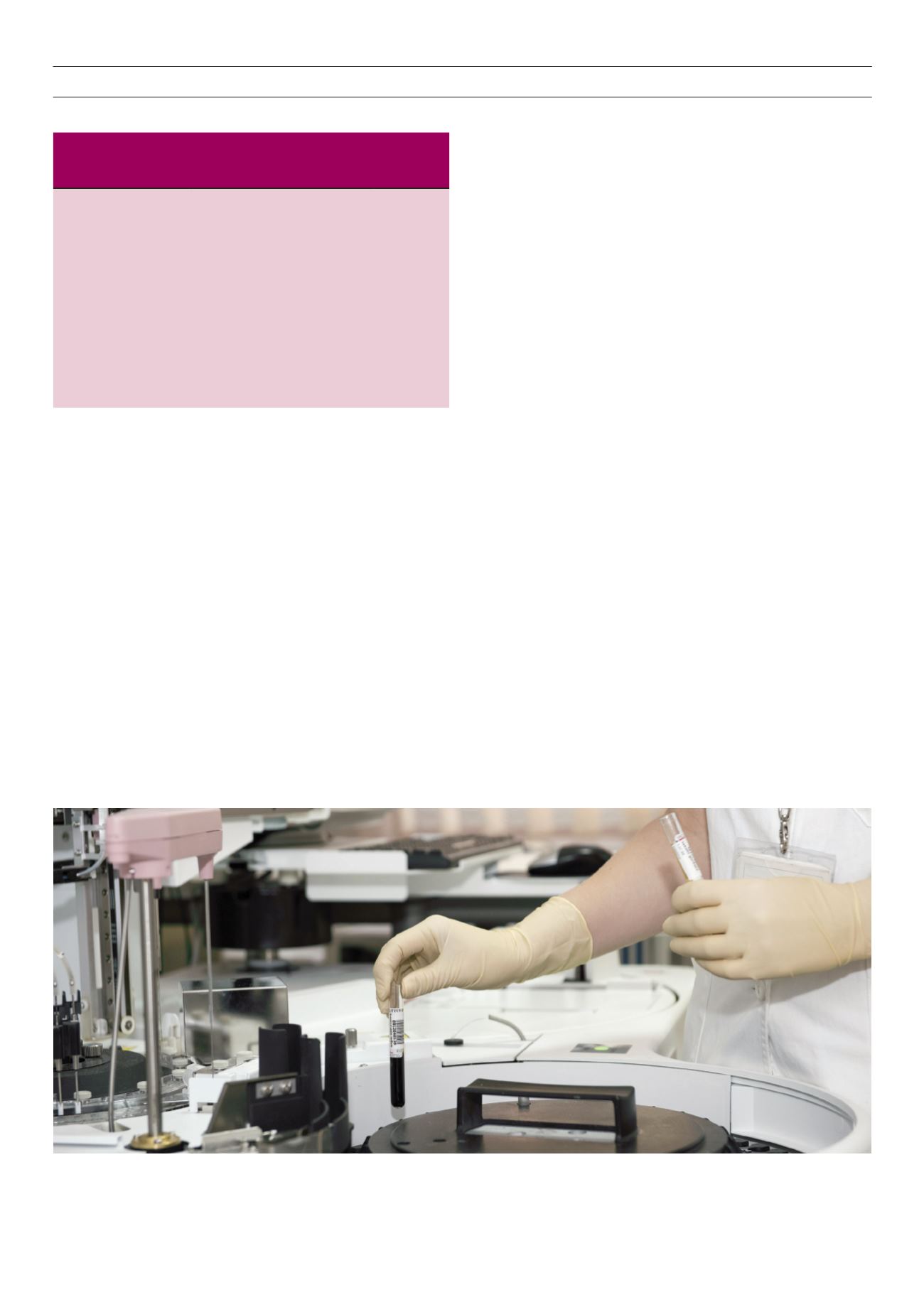

RESEARCH ARTICLE
SA JOURNAL OF DIABETES & VASCULAR DISEASE
36
VOLUME 14 NUMBER 1 • JULY 2017
We determined homocysteine levels in 39 hypertriglycerid-
aemic and 38 hypercholesterolaemic subjects. No statistically
significant association was found between homocysteine and
hypertriglyceridaemia (
p
= 0.442) and hypercholesterolaemia
(
p
= 0.480) (Table 2). Three hypertriglyceridaemic subjects had
hyperhomocysteinaemia (7.7%) while five hypercholesterolaemic
subjects had hyperhomocysteinaemia (13.1%) (Table 3). The
insignificant association was supported by the findings of Vayá
et al
.
15
However, Nabipour
et al
. found significant associations
between lower HDL cholesterol and high homocysteine levels.
20
Homocysteine levels were estimated in 72 subjects with high
systolic blood pressure and 84 subjects with high diastolic blood
pressure, a total of 156 hypertensive subjects. Homocysteine
was statistically significantly associated with both systolic (
p
=
0.002) and diastolic (
p
= 0.033) blood pressure (Table 2). Eleven
hypersystolic subjects (15.3%) were hyperhomocysteinaemic while
16 hyperdiastolic subjects (19%) were hyperhomocysteinaemic
(Table 3). These findings are supported by various researchers, who
found hyperhomocysteinaemia to be significantly associated with
hypertension.
10,20-22
The association of homocysteine with hypertension may be
due to the fact that homocysteine induces arteriolar constriction,
renal dysfunction and increased sodium absorption, with
increased arteriolar stiffness.
18
It increases oxidative stress, which
causes oxidative injury to the vascular endothelium, diminishing
vasodilation by nitric oxide. It also stimulates the proliferation of
vascular smooth muscle cells and alters the elastic properties of the
vascular wall, leading to an increase in hypertension.
18
On the basis of our findings, the large body of supporting
evidence and the mechanisms of association, homocysteine levels
can be used to track blood pressure. Hyperhomocysteinaemia
reflects a causal effect rather than being concomitant to elevated
blood pressure.
In our present study we evaluated 95 obese subjects for
homocysteine association with obesity. We found a borderline
association (
p
= 0.080) (Table 2). Ten obese subjects were
hyperhomocysteinaemic (Table 3). The association was partly
supported by other researchers, who found increased prevalence
of hyperhomocysteinaemia in obese subjects.
10,15,36
Depending on
age and the pattern of obesity, homocysteine may be significantly
associated with obesity. This viewpoint is supported by the findings
of Vayá
et al
.
15
and El-Sammak
et al
.
37
Conclusion
We found no statistically significant relationship between baseline
plasma homocysteine levels and hyperglycaemia, dyslipidaemia
and obesity. There was, however, a significant relationship between
homocysteine levels and hypertension. According to our cross-
sectional study, high baseline plasma homocysteine level is a major
risk factor for hypertension and can be used in blood pressure
tracking in a large, community-based sample. The study supported
the hypothesis that plasma homocysteine is casually related to
elevated blood pressure.
Additional prospective investigations are recommended to
confirm these findings. A study evaluating the association between
plasma homocysteine levels and hyperglycaemia after a few days
of treatment withdrawal would probably yield better and more
reliable results. Unfortunately, withdrawing treatment from diabetic
Table 3.
Prevalence of hyperhomocysteinaemia with hyperglycae-
mia, hypertriglyceridaemia, hypercholesterolaemia, hypertension and
obesity
Hyperhomocystein-
aemia
Metabolic disorder
Prevalence
rate (%)
n
= 3
Hyperglycaemia (
n
= 45)
6.7
n
= 3
Hypertriglyceridaemia (
n
= 39)
7.7
n
= 5
Hypercholesterolaemia (
n
= 38)
13.1
n
= 11
Systolic blood pressure (
n
= 72)
15.3
n
= 16
Diastolic blood pressure (
n
= 84)
19.0
n
= 10
Obesity (
n
= 95)
10.5
Prevalence of hyperhomocysteinaemia = number of hyperhomocysteinaemic
subjects per number of subjects in the respective components of the metabolic
syndrome.



















